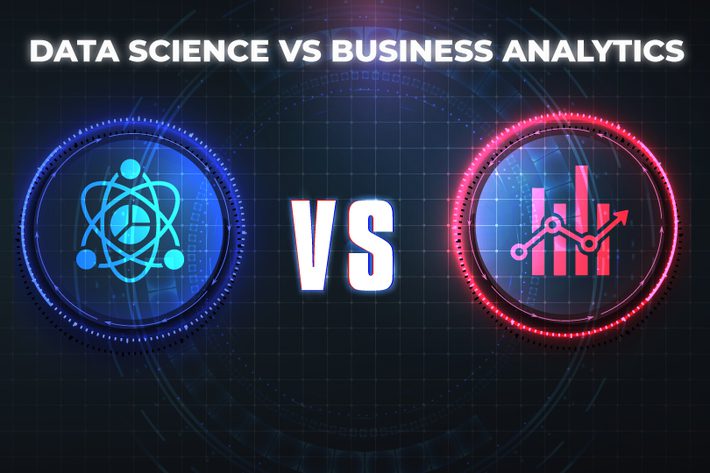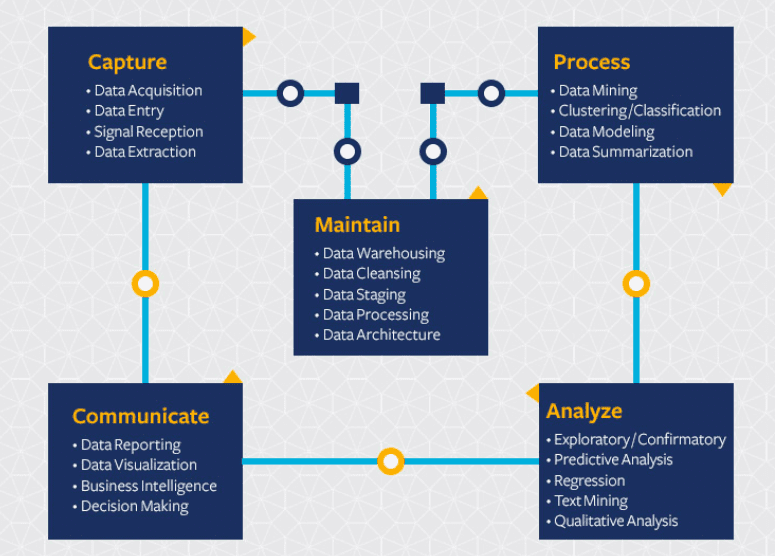We will talk about two chief technologies that deal with data namely Business Analytics and Data Science. The latter is specific to customer choice, geographical influences concerning the business, and the former deals with business issues that relate to profit, cost, etc.
Therefore, on the prima facie, they are quite related to each other and are used interchangeably but in reality, are quite different from each other.
Business Analytics as we know existed for quite a long time more than 2 decades from the late 20th century. However, data science gained momentum in the 21st century roughly around the year 2008.
Let us begin from the basics and yes you must understand about data briefly.
Data is in raw form and the processed data is called information. You need to know the Data Life Cycle Management (DLCM) and the classification of data.
Data existed in raw form even before the computer era in the form of books or libraries. But after the Digital revolution, data and information co-existed and are found in the digital form accessible to all.
The explosion and exponential growth of data started in early 2010. They became a common phenomenon after the discovery and use of the internet. Only in the last 3 years, huge data has been created with the help of digitization. Before this, all data were contained randomly and hence is now reachable.
What is DLCM or Data Life Cycle Management?
The data that is initiated or ideated, then it is created, followed by classified, stored, accessed, processed, stored again, used, and finally destroyed is called the Data Life Cycle Management.
Typically the data in the digital world is classified as
|
Structured |
Semi-Structured |
Unstructured |
|
Data is visible and understandable |
Not very structured at the same time no random. Has some correlation |
Random data |
|
Very limited processing is required to interpret the data |
Little analysis is required for understanding the data |
Requires a lot of processes to convert into meaningful data |
What is Data Science?
To differentiate business analytics from data science, know about data science.
It is an interdisciplinary field that works towards decoding and demystifying large datasets namely the big data by making use of a combination of maths, statistics, information science, computer science, machine learning, data analysis, and other related fields of study.
Data Science as such follows 5 steps:
- Data capturing is done
- Captured data is maintained
- Then they are processed
- Such processed data is analyzed
- Finally, reporting is done
Find a detailed explanation of the same in the picture depicted below.
What is Business Analytics?
The technology used and the practice followed to collect, collate, process, analyze, and study the data related to any business for monitoring the business performance as well as to expand the scope of improving the business planning and future of business is called business analytics.
Business Analyst Role :
Business Analyst makes use of various forms of quantitative analysis, statistical, predictive, analytical modeling, and iterative methods for getting the insights of the business data. Thus with the obtained data, they get a hold about the business past which helps them to devise a plan for a successful business. Further, it also paves the way to solve complex problems in business operations and improves sales and revenue generation. Overall, the productivity of the team is increased.
Four types of Business Analytics :
1) Descriptive – This form of analytics answers the question of “What has happened?” and is the most basic form of analytics which does not require high-end tools but can be done manually by using excel sheets etc.
2) Diagnostic – Here it mainly focuses on answering the question “Why did it happen?” and this answer can be found by using analytics tools such as drill-down, data discovery, data mining, and correlations.
3) Predictive – The future in analytics comes into picture here as it predominantly deals with finding an answer to the question “What will happen in the future?” Statistical and mathematical tools help to find answers to this question.
The Predictive Business Analytics can be further divided under the sub-categories as follows:
- What next? Predictive Modelling
- Why did it happen? Root Cause Analysis (RCA)
- Data identification and correlation – Data Mining
- What will happen with this trend if continued? Forecast
- Simulation to find what will happen? – Monte-Carlo Simulation
- When to invoke action and rectify the process. – Pattern Identification and Alert
4) Prescriptive – Now, comes the action point from a business perspective, “What should a Business do?” Optimization and simulation tools are widely used for this purpose.
How are Both Correlated ?
Business Analytics can be termed as part of Data Science. Data Science encompasses a lot of interdisciplinary fields such as computer science, mathematics, statistics, data analytics, and programming, Artificial Intelligence, Machine Learning, Neural Networks, and Deep Learning to solve complex problems consisting of large data sets.
Whereas, Business Analytics is used for solving specific business problems using optimization, simulation, statistics, and mathematics.
Why should you know the Difference ?
You should know the difference between both so that you can choose a career in business analytics or data science as it requires you to exhibit your talents and skills in your chosen area.
For instance, data science requires advanced knowledge of programming and coding in general and many areas as described above.
Whereas if your skills are limited and more towards mathematics, optimization, simulation, operations research, statistics, and data analytics you can choose the topic of Business Analytics as your chosen career path.
What is the major difference between Data Science and Business Analytics ?
|
Categories |
Business Analytics |
Data Science |
|
Skills Required |
Requires skills in Mathematics, Simulation, Optimization, Operations Research and Statistics |
Requires interdisciplinary skills in Computer Science, Programming, Statistics, Data Analytics, Mathematics, AI, ML, Deep Learning and Neural Networks |
|
Data Usage |
Use of Business data |
Use of Large data sets called big Data |
|
Type of data used |
Use only structured Data |
Use all the 3 types of data |
|
Why it is used |
Used to get Business Insights on Business Operations, Revenue Generation, Forecasting sales, and to increase productivity.
Is used to solve specific business problems |
Used to get answers to the User and sensors behaviors and solves very complex problems Is used for Sensors and Users behaviors trends and patterns |
|
Stages or types |
Four types of Business Analytics – Descriptive, Diagnostic, Predictive and Prescriptive |
Has five stages – Capture, Maintain, Process, Analyze and Communicate |
|
Where they can be applied to? Industries |
Applications of Business Analytics in Marketing, Technology, Retail, and Finance |
Applications of Data Science in Education, Technology, Finance, and E-Commerce |
|
Critical or not |
Is used for making critical decision making |
Data Science results are not used for making critical decisions |
|
Future |
Used in the future for doing Tax Analytics and Cognitive Analytics |
Can be used for doing Artificial Intelligence and Machine Learning applications |
|
Role |
Statistical analysis |
Coding, and programming |
|
Coined in |
19th Century |
2008 |
|
In short |
Statistical Study of data |
Data studied using statistics |
|
Cost on Investment |
In medium scale |
In large scale |
|
Type of Industry |
Small, Medium and Large Enterprises |
Used in Large Enterprises |
|
Tools Used |
MS Excel, Databases, and Statistical Tools such as SAS and Regression Analysis, etc. |
Python, AI, Algorithms, ML, R Programming, Hadoop, Deep Learning Algorithms and Neural Networks, etc. |
|
People Employed |
In moderate scale |
In large scale |
|
Salary and Pay Scale |
At par with other IT jobs |
Very highly paid because of the demand, knowledge required and technologies to be used |
|
Type of work |
A business-as-usual job requiring many iterations |
The work involves a lot of research and a lot of data mining work |
|
Return on Investment (ROI) |
Moderate and immediately realized |
Very high and takes a long time to realize |
|
Functional Area |
Requires the work specific to Business |
Requires cross-functional and interdisciplinary work |
Confused between choosing a Business Analytics profile or Data Scientist ?
Let us walk you through role-specific differences allowing you to choose the best to fit in your career aspirations.
|
Categories |
Business Analytics Roles |
Data Science Roles |
|
Strong in Programming |
Do not take this |
This is the right fit |
|
Out of College |
Can take up this role |
Can take up this role as well |
|
Mid-Career shift with 5 to 10 years down after the college |
Easy to jump to this role |
Requires programming knowledge and a lot of hard work |
|
Type of Job |
Once you learn the fundamentals it is quite iterative afterward |
Requires a lot of Research and Development |
|
Concerned about the Payscale |
Moderately paying at par with other IT and software jobs |
Highly-paid because of the skills and talents required |
|
Love Creativity |
Yes requires a high amount of creativity |
Requires more hard work than being creative |
|
Analytical |
Required |
Required |
|
Fond of Statistics |
The best job for you |
Need in small scale |
|
Want to work with Algorithms |
Not suitable for you |
Most suitable for you |
|
Willing to take an intellectually taxing job |
Not suitable for you |
This is the most suitable job |
|
Time and Investment in Learning |
Very less time required |
Need a lot of time and investment in learning but provides high returns |
|
Adaptation |
Needs less adaptive nature |
Needs more adaptive nature to the newer technologies |
Final Thoughts :
In a nutshell, the statistical study of business data is business analytics and data study that uses technology, algorithms, and statistics in data science. Business analytics professionals will break data science into fresh chunks at the same time when a program is in progress. This means you can choose to become a business analytics person or a data science expert.
The choice is yours depending on your skills and interest. Both areas have a wide scope for learning and offer great career opportunities.
Originally posted here


